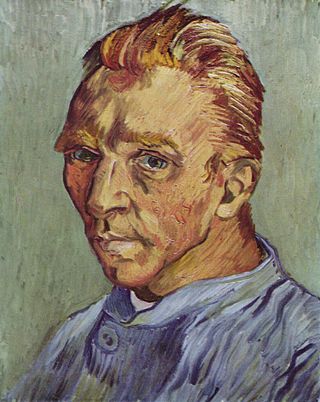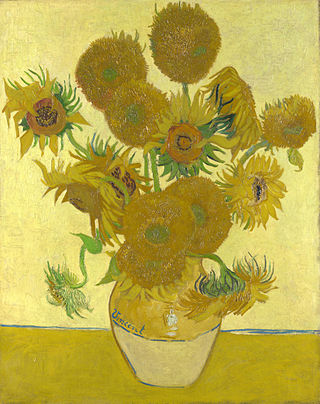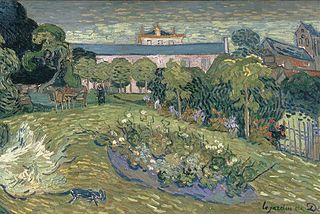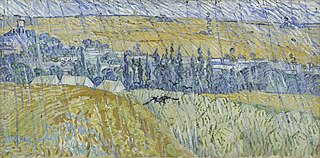
Vincent Willem van Gogh was a Dutch Post-Impressionist painter who is among the most famous and influential figures in the history of Western art. In just over a decade he created approximately 2100 artworks, including around 860 oil paintings, most of them in the last two years of his life. They include landscapes, still lifes, portraits and self-portraits, and are characterised by bold, symbolic colours, and dramatic, impulsive and highly expressive brushwork that contributed to the foundations of modern art. Only one of his paintings was known by name to have been sold during his lifetime. Van Gogh became famous after his suicide at age 37, which followed years of poverty and mental illness.

The portraits of Vincent van Gogh (1853–1890) include self-portraits, portraits of him by other artists, and photographs—one of which is dubious—of the Dutch artist. Van Gogh's dozens of self-portraits were an important part of his œuvre as a painter. Most probably, van Gogh's self-portraits are depicting the face as it appeared in the mirror he used to reproduce his face, i.e. his right side in the image is in reality the left side of his face.

Sunflowers is the title of two series of still life paintings by the Dutch painter Vincent van Gogh. The first series, executed in Paris in 1887, depicts the flowers lying on the ground, while the second set, made a year later in Arles, shows a bouquet of sunflowers in a vase. In the artist's mind, both sets were linked by the name of his friend Paul Gauguin, who acquired two of the Paris versions. About eight months later, Van Gogh hoped to welcome and impress Gauguin again with Sunflowers, now part of the painted Décoration for the Yellow House that he prepared for the guestroom of his home in Arles, where Gauguin was supposed to stay. After Gauguin's departure, Van Gogh imagined the two major versions as wings of the Berceuse Triptych, and finally, he included them in his Les XX in Bruxelles exhibit.

Charles Laval was a French painter associated with the Synthetic movement and Pont-Aven School.
Vincent van Gogh lived during the Impressionist era. With the development of photography, painters and artists turned to conveying the feeling and ideas behind people, places, and things rather than trying to imitate their physical forms. Impressionist artists did this by emphasizing certain hues, using vigorous brushstrokes, and paying attention to highlighting. Vincent van Gogh implemented this ideology to pursue his goal of depicting his own feelings toward and involvement with his subjects. Van Gogh's portraiture focuses on color and brushstrokes to demonstrate their inner qualities and Van Gogh's own relationship with them.

Vincent van Gogh made many copies of other people's work between 1887 and early 1890, which can be considered appropriation art. While at Saint-Paul asylum in Saint-Rémy-de-Provence, France, where Van Gogh admitted himself, he strived to have subjects during the cold winter months. Seeking to be reinvigorated artistically, Van Gogh did more than 30 copies of works by some of his favorite artists. About twenty-one of the works were copies after, or inspired by, Jean-François Millet. Rather than replicate, Van Gogh sought to translate the subjects and composition through his perspective, color, and technique. Spiritual meaning and emotional comfort were expressed through symbolism and color. His brother Theo van Gogh would call the pieces in the series some of his best work.

Daubigny's Garden, painted three times by Vincent van Gogh, depicts the enclosed garden of Charles-François Daubigny, a painter whom Van Gogh admired throughout his life.

Le Moulin de la Galette is the title of several paintings made by Vincent van Gogh in 1886 of a windmill, the Moulin de la Galette, which was near Van Gogh and his brother Theo's apartment in Montmartre. The owners of the windmill maximized the view on the butte overlooking Paris, creating a terrace for viewing and a dance hall for entertainment.

Vase with Poppies is an 1886 oil painting created in Paris, France by Post-Impressionist Dutch artist Vincent van Gogh.

Wheat Fields is a series of dozens of paintings by Dutch Post-Impressionist artist Vincent van Gogh, borne out of his religious studies and sermons, connection to nature, appreciation of manual laborers and desire to provide a means of offering comfort to others. The wheat field works demonstrate his progression as an artist from the drab Wheat Sheaves made in 1885 in the Netherlands to the colorful and dramatic 1888–1890 paintings from Arles, Saint-Rémy and Auvers-sur-Oise in rural France.

Asnières, now named Asnières-sur-Seine, is the subject and location of paintings that Vincent van Gogh made in 1887. The works, which include parks, restaurants, riverside settings and factories, mark a breakthrough in van Gogh's artistic development. In the Netherlands his work was shaped by great Dutch masters as well as Anton Mauve a Dutch realist painter who was a leading member of the Hague School and a significant early influence on his cousin-in-law van Gogh. In Paris van Gogh was exposed to and influenced by Impressionism, Symbolism, Pointillism, and Japanese woodblock print genres.

The Montmartre paintings are a group of works that Vincent van Gogh created in 1886 and 1887 of the Paris district of Montmartre while living there, at 54 Rue Lepic, with his brother Theo. Rather than capture urban settings in Paris, van Gogh preferred pastoral scenes, such as Montmartre and Asnières in the northwest suburbs. Of the two years in Paris, the work from 1886 often has the dark, somber tones of his early works from the Netherlands and Brussels. By the spring of 1887, van Gogh embraced use of color and light and created his own brushstroke techniques based upon Impressionism and Pointillism. The works in the series provide examples of his work during that period of time and the progression he made as an artist.

Seine (paintings) is the subject and location of paintings that Vincent van Gogh made in 1887. The Seine has been an integral part of Parisian life for centuries for commerce, travel and entertainment. Here van Gogh primarily captures the respite and relief from city life found in nature.

Peasant Character Studies is a series of works that Vincent van Gogh made between 1881 and 1885.

Van Gogh's family in his art refers to works that Vincent van Gogh made for or about Van Gogh family members. In 1881, Vincent drew a portrait of his grandfather, also named Vincent van Gogh, and his sister Wil. While living in Nuenen, Vincent memorialized his father in Still Life with Bible following his death in 1885. There he also made many paintings and drawings in 1884 and 1885 of his parents' vicarage, its garden and the church. At the height of his career in Arles he made Portrait of the Artist's Mother, Memory of the Garden at Etten of his mother and sister and Novel Reader, which is thought to be of his sister, Wil.

Still life paintings by Vincent van Gogh (Netherlands) is the subject of many drawings, sketches and paintings made during Vincent van Gogh's early artistic career. Most still lifes made in the Netherlands are dated from 1884 to 1885, when he lived in Nuenen. His works were often in somber colors. Van Gogh experimented with the use of light falling across objects.

Still life paintings by Vincent van Gogh (Paris) is the subject of many drawings, sketches and paintings by Vincent van Gogh in 1886 and 1887 after he moved to Montmartre in Paris from the Netherlands. While in Paris, Van Gogh transformed the subjects, color and techniques that he used in creating still life paintings.

Houses at Auvers is an oil painting by Vincent van Gogh. It was created towards the end of May or beginning of June 1890, shortly after he had moved to Auvers-sur-Oise, a small town northwest of Paris, France.

Landscape at Auvers in the Rain is an oil painting on canvas by the Dutch Post-Impressionist painter Vincent van Gogh.




















